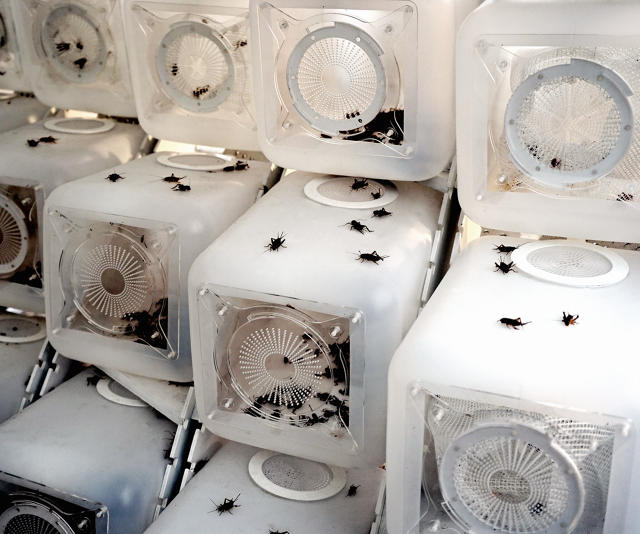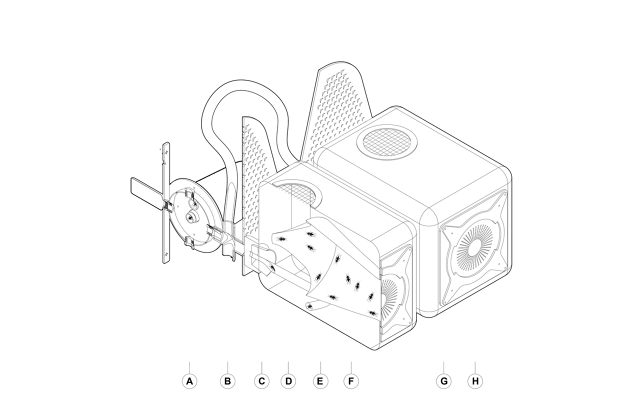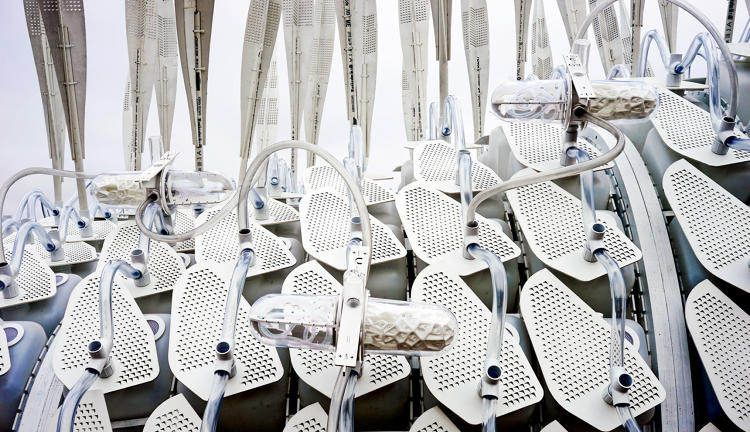This Modular Cricket Pod Lets You Create An Urban Insect Farm
Walking up to the Cricket Shelter—a new tent-like structure sitting on a dock at the Brooklyn Navy Yard—it might not immediately be obvious that it’s full of bugs. But inside pods lining the walls, the prototype is raising 22,000 crickets. Why? To eat, of course.
As the bug food trend continues, the Cricket Shelter is designed to make it local. The shelter can easily pop up on a rooftop or empty lot.
“They would fit right into the massive onslaught of urban farms that are happening in Brooklyn and the rest of New York,” says Mitchell Joachim, founder of Terreform, the architecture firm that designed the modular cricket farm. “These farms would be great alongside solar panels and other things you’d probably want to grow on the roof. So there’s an enormous amount of opportunity to have this produced locally.”

Several startups are working on new systems to raise crickets, driven in part by the fact that insect protein has a tiny environmental footprint compared to beef or chicken. But while others work on industrial-scale, automated cricket farms, the Cricket Shelter is designed as a simple system that could also work for small producers.
Unlike a typical DIY cricket farm, the Cricket Shelter is designed to produce a product they say is cleaner than some farms. “They kind of collect the dead crickets and their poop and any other bits of slop and they mix it all up,” says Joachim. The new system is simple to clean, and the crickets can be harvested by turning a dial on each pod and emptying it out.
The design also lets crickets move around—the cricket version of something close to free-range—while also raising as many insects as possible. As the crickets grow, the designers are experimenting with how their feed can change the flavor.

“We’re very interested in gut-loading them with orange peels, apple cores, lime rinds, so they actually taste exquisite,” he says. “They absorb that into their body’s metabolism.”
Quill-like shapes on the top of the shelter help with ventilation, sucking stale air out of the colonies so the shelter doesn’t smell like crickets. As a side effect, the quills pick up the sound of the male crickets chirping and amplify it in the surrounding area.
It’s a pleasant place to be, and that’s by design. The architects originally created the shelter for disaster zones—where the farms can double as a somewhat strange place to sleep. After a disaster, “people don’t just need a place to protect themselves from the elements,” Joachim says. “They actually need to get access to food.”
In a disaster, the design would be simplified to a basic arch shape that’s easy to quickly replicate. As someone sleeps under the arch—surrounded by the chirping of crickets—Joachim thinks it could be relaxing.
“I think it beats a cardboard shelter or some vinyl tarp that’s flapping in the wind,” he says. “Here you have the sound of an organism that supplies sustenance for yourself and your family. As long as you have that, there’s a bit of comfort that you can make it through this disaster. Once the disaster’s complete, you can still use these shelters as a source of income.”
At the moment, however, the designers are focused on how the farms can become part of the local food scene in New York. Robyn Shapiro, an entrepreneur who plans to launch a line of insect-based snacks this summer, has been collaborating with the designers. “Being able to create a 100% local product is exciting,” she says.

After the crickets are harvested, they are ground into a powder that can be used in food. “We’re not interested in making crickets that you just mash up and eat,” says Joachim. “I think Americans, especially New Yorkers, are not going to eat eyeballs and legs—I can’t even do that.”
Cricket powder is already quickly becoming acceptable, and in some cases, used in high-end restaurants. Joachim compares it to sushi; when sushi was first introduced in the U.S., older generations didn’t like the idea of eating raw fish.
“It went from completely absurd and mostly disgusting to what you do when you really like someone and you want to go out on a nice date,” he says. “I think insects will have a similar narrative. There will be first adopters. But if it really gets transported into the level of a Michelin-rated restaurant, I think that really helps trickle it down to the Homer Simpsons of America, who can think of this as a realistic replacement in their diet. And then without knowing, do something great for the atmosphere.”
As the bug food trend continues, the Cricket Shelter is designed to make it local. The shelter can easily pop up on a rooftop or empty lot.
” src=”http://b.fastcompany.net/multisite_files/fastcompany/imagecache/slideshow_large/slideshow/2016/04/3059181-slide-2-this-modular-cricket-pod.jpg”>
The design also lets crickets move around—the cricket version of something close to free-range—while also raising as many insects as possible.
” src=”http://d.fastcompany.net/multisite_files/fastcompany/imagecache/slideshow_large/slideshow/2016/04/3059181-slide-4-this-modular-cricket-pod.jpg”>
Quill-like shapes on the top of the shelter help with ventilation, sucking stale air out of the colonies so the shelter doesn’t smell like crickets.
” src=”http://b.fastcompany.net/multisite_files/fastcompany/imagecache/slideshow_large/slideshow/2016/04/3059181-slide-6-this-modular-cricket-pod.jpg”>
It’s a pleasant place to be, and that’s by design.
” src=”http://a.fastcompany.net/multisite_files/fastcompany/imagecache/slideshow_large/slideshow/2016/04/3059181-slide-7-this-modular-cricket-pod.jpg”>
In a disaster, the design would be simplified to a basic arch shape that’s easy to quickly replicate.
” src=”http://a.fastcompany.net/multisite_files/fastcompany/imagecache/slideshow_large/slideshow/2016/04/3059181-slide-illo-2-this-modular-cricket-pod.png”>
Fast Company , Read Full Story
(26)














